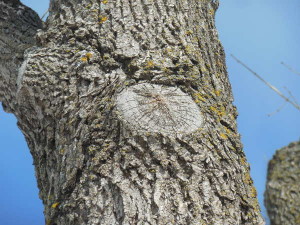Pruning trees: Do I need a pruning sealer?
Healed cut
For decades it was a common belief that applying pruning sealer to tree wounds was the perfect remedy for preventing decay and insect infestation in trees. Although applying a wound dressing may be helpful in some situations, it’s important to remember that it can have a negative impact as well.
So before you head into the yard with a chainsaw in one hand and a can of spray paint in the other, keep the following information in mind.
Decay from a bad cut
- Trees are governed by a complex biological system regulated by natural resources. By adding pruning sealer you’re more likely to seal in moisture, which will slow the healing process and prevent sunlight from drying the wound.
- Dark areas with trapped moisture are the perfect atmosphere for the development of fungi, which can lead to decay in trees.
- Pruning sealers are asphalt and petroleum based products which are toxic to plants. If pruning sealer is applied to a tree wound, the vascular system may be working just as hard to prevent the translocation of toxic chemicals throughout the canopy as it will to heal the wound.
One of the most important areas of a tree which helps prevent decay and insect damage is the area called the branch protection zone. It can be found just outside the branch bark ridge and branch collar.
By making your final cut just outside this area at a 45 degree angle away from the tree, the branch protection zone will remain in tact and be able to perform its primary function of wound enclosure. To help facilitate this process, make sure the tool you’re using has a sharp blade or chain.
Although it is known that wound dressings do not prevent decay or increase the likelihood of wound enclosure, there are situations where the application of a pruning sealer is necessary.
If pruning a tree during high risk disease season, for example oak wilt (Ceratocystis fagacearum). A light coating of pruning sealer can mask the scent emitted from tree wounds, that can attract insects carrying the oak wilt pathogen. We do not trim oaks in the high risk season unless it’s absolutely necessary to trim a broken limb. A wise person once said “the best defense is a good offense.”
In this case a great offense would be a combination of applying the proper cutting technique, using a sharp tool and pruning during the right time of year. If you’re going to use a wound dressings, make sure it’s not a petroleum based product. Following these rules will increase the likelihood of full wound compartmentalization, while at the same time allowing the tree to naturally recover on its own.
Good luck and safe cutting! Keith Curtis ISA Certification #MN4130-A



